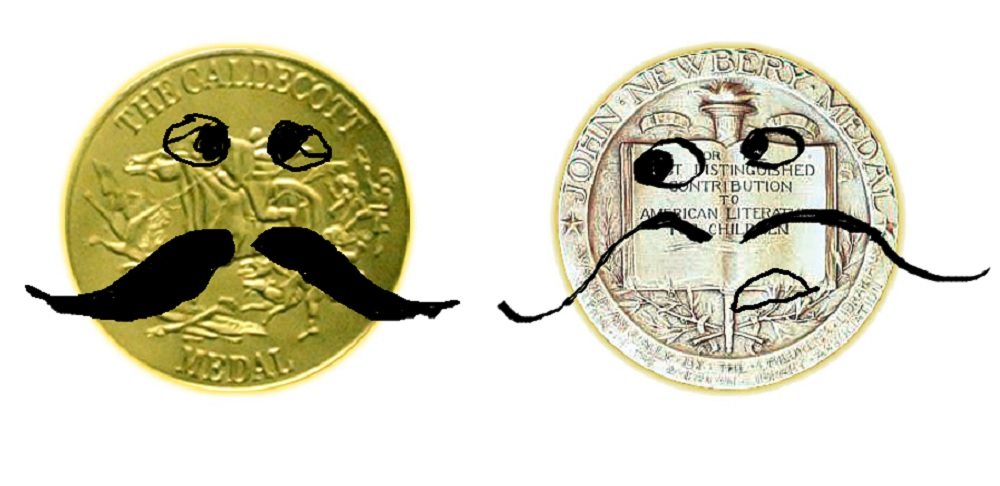
Awards season is upon us, and critics, fans, and those in-between folks who do things like write for geek blogs have all been rounding up their favorite Whatevers of 2016 and are predicting which ones might take The Big Awards.
It might be fun to make your own predictions as a family, but if your children are younger than teenagers, most of the contenders for prizes like Golden Globes or Oscars aren’t going to cut it with them. But my favorite awards announcement, coming up this year on January 23, is the American Library Association’s Youth Media Awards, and these can be fun for the whole family.
I’ve been holding a Mock Caldecott at my public library for the past five years or so. The Caldecott goes to the illustrator for the pictures in a book, so even pre-readers can vote, and everyone can look over a large number of contenders right there in the library, in the course of a one-hour program. Most of the YMAs, including the Caldecott, do not release a public list of nominations* before the awards are given, so you can’t just read all the nominees beforehand like you could, say, watch all the Best Picture nominees. You have to do a little digging and see which books are getting a lot of buzz. I gather lists from blogs and other organizations doing their own Mock Caldecotts, like The Horn Book‘s Calling Caldecott, or the ever-being-voted-upon Goodreads list.
Keep in mind that the award can go to any illustrated book published for the first time in 2016 by either an American illustrator (regardless of residency) or an illustrator living in the United States (like multi-awarded Canadian Jon Klassen), for children aged 0-14. That means that not only may some great books not be eligible because of where and when they were published, but there are other books eligible that some people might not have even considered because they’re not a typical 32-page picture book, like 2008’s medalist The Invention of Hugo Cabret or 2015’s YA graphic novel honor book This One Summer. But it’s okay if you don’t have the real winner in your pile for a Mock Caldecott. I grab whatever books on the lists my library happens to have in on the day of the program.
Then we go over the criteria for the Caldecott awards. The most important part, in plain English, is that the award is for, not necessarily the most well-made artwork (although that’s part of it), but artwork that is creative and fully helps to tell the story (without simply drawing exactly what the words already say). Everyone has a chance to pore over the books, then they fill out a ballot.
Everyone lists their top three choices, in order, on the ballot, and then I tally the results by weighting the votes: first choices get three points, second choices two points, and third choices get one point. That way equal consideration goes to how much people liked the book and to how many people liked the book. The book with the most points is your Medalist. Honors go to books that scored nearly as high as the Medalist: there is no set number of Honors that can be awarded. Theoretically, you could have NO Honor Books, though in real life some people felt a little slighted when there were only two Honor books in 2010 and 2011. 2015 made up for that with six Honor books. It all depends how hard it is to make up your minds!
I like to throw some extra activities into the experience by having everyone try to create artwork in the style of previous winners. Two of my favorite techniques to suggest are scratchboard a la Beth Krommes and pasting illustrated characters on real photographic backgrounds a la Mo Willems. But if you’re really feeling adventurous, try Denise Fleming‘s poured-paper-pulp illustration technique!
This year I have an extra week of pre-YMAs programming to play with and am trying something new: a Mock Geisel. The Geisel Award (named for a certain Theodore Seuss Geisel) is given to books for beginning readers that make learning to read fun. The focus is on the words, but the stories are, by necessity, short, so they don’t take long for the grown-ups in the crowd to read. And who better to test that an Easy Reader is fun to read than beginning readers themselves? I’ve gathered these possibilities from similar sources: Goodreads has a Mock Geisel list, too, and blogs like Guessing Geisel are a must. For a bonus activity, take a list of common sight words, and try to write a story using only those words. Now try to write a good story using only those words. Tricky, isn’t it? That’s why Geisel winners truly earn their awards!
The oldest and most famous of the YMAs is the Newbery, given to the most well-written American children’s book of the year. Although last year’s award went to a picture book, most contenders are novel-length, so you would have to get a long head start to read and discuss those. But if you have serious bookworms in your family who want to crack as much of these Newbery buzz lists as possible in the next two weeks, give it a try!
I hope you can tune in on January 23 to cheer on your favorites at the best awards show of the year!
*The exceptions are the Excellence in Nonfiction for Young Adults Award and the William C. Morris Award for the best YA debut. You can see this year’s contenders at those links!




Great article! We do a Mock Caldecott at our library but pick 6 books with our school librarians for people to look at and vote on over a six week time frame. I might try the program you described next year. Thanks!